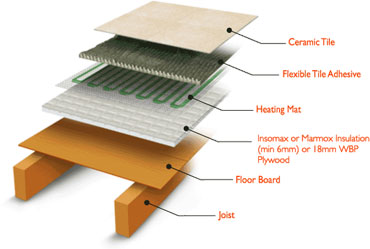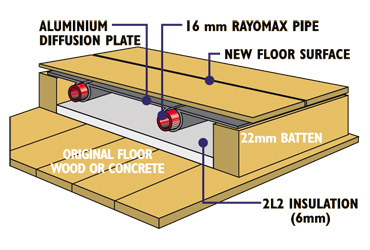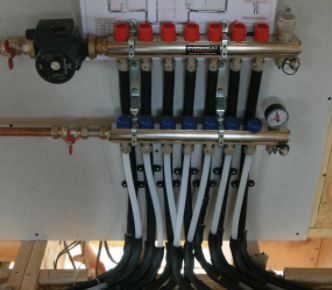Advantages of electric underfloor heating vs warm water underfloor heating
11 Apr 2016
After being informed of the many benefits of underfloor heating (UFH), your next dilemma however is which system to go for; (A) Warm Water Underfloor Heating or (B) Electric Underfloor Heating? This article highlights the advantages of electric underfloor heating over warm water underfloor heating.
Get KIT prices from our online shop
(1) Ease of installation
(A) New Screeded Floors
Both electric and warm water underfloor heating are very cheap and simple to install within/on new screed floors.
- Water UFH -The warm water pipes are typically laid on top the insulation with the screed poured on top.
- Electric UFH -Electric underfloor heating mats are laid on top of the screed just underneath the final floor covering. This allows it to have a faster warm up time.
(B) Existing concrete floor
- Water UFH: Water underfloor heating is often difficult to install in refurbishments as the concrete floors are often already down so you have to build a false floor to accommodate the piping. This is time consuming and expensive.
- Electric UFH: Electric underfloor heating is incredibly easy as it simply lays under the new floor covering.
(C) Suspended wooden floors
- Electric UFH: The heating mat is installed on top of the floorboards. The final floor covering is typically installed directly above. It's just as easy as installing on top of a screeded floor
- Water UFH: Water underfloor heating however is more time consuming when you have suspended wooden floors because:
- Each joist has to be notched to allow the piping to pass
- Expensive diffusion plates must be used to transfer the heat across the wooden floor
- It is more difficult to work off a floor that isn’t solid (ie walking on joists).
(2) Warm up time
(A) Screeded floors:
- Water UFH: Water underfloor heating pipes are buried in 75-90mm of screed. Although the screed is a relatively good conductor of heat it does take a while for the warm water underfloor heating pipes to heat the screed before the room can be heated.
- Electric UFH: A thin layer of insulation is placed on top of the concrete floor and the heating mat lays directly on top. As the heat only has to travel through the floor covering the warm up time is fast.
(B) Wooden suspended floors:
- Water UFH: Wood is not a great conductor of heat and as the warm water underfloor heating pipes have to be installed under the wooden floors this limits the choice of floor covering. It is fine if the floor covering is tiles or the wooden floor boards are to be the final covering. It is not however suitable for thick carpets or floating laminate / engineered wooden floors.
- Electric UFH: As electric underfloor heating is installed on top of the wooden floor boards you have much more freedom when choosing your final floor covering.


(3) Cost of Installation
In a new build: The material cost of electric and warm water underfloor heating materials are often very similar. The most cost effective place to install warm water underfloor heating is within a new concrete floor. In all other scenarios electric underfloor heating is typically much easier and cheaper to install.
In a refurbishment: With electric underfloor heating all installation scenarios are very fast and easy. The easiest and fastest floor coverings to install under are floating wooden floors or carpets. Tiles are a little more time consuming and the lengthiest are Amtico or Karndean floors as the mats have to be covered by a self levelling compound.
(4) Cupboard space
- Electric UFH: There are no manifolds required for electric underfloor heating systems.
- Water UFH: Warm water underfloor heating systems require a manifold on each floor, for large properties there may even be multiple manifolds on each floor. This obviously takes up valuable space which you could put to better use.

(5) Floor height when retrofitting
When retrofitting warm water underfloor heating on top of an existing concrete floor, you have to build a false wooden floor to accommodate the piping. By raising the floor height you have a whole range of problems such as door height, sideboards, kitchen units, electric sockets etc. As electric underfloor heating is so thin it doesn’t effect the floor height avoiding all these problems.
(6) No boiler
- The cost of installing a new boiler can easily be £3000 or more. By going all electric you can save all that money.
- In a new build there is no need to run a gas pipe to your property from the street gas mains saving you money.
- The ongoing maintenance and repair of boilers can cost hundreds of pounds every year.
- Increased safety by reducing gas appliances in the property.
Related reading
Discover more on the following pages




